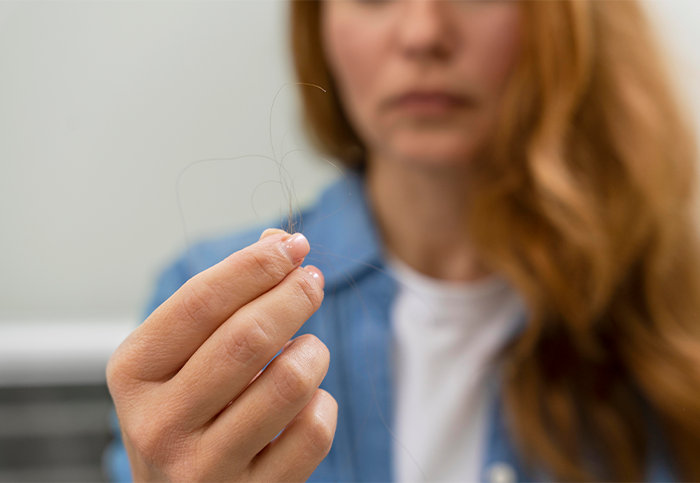8 Symptoms of Iron Deficiency Anemia
Anemia is a condition in which the number of red blood cells becomes lower than the normal levels in the body and ultimately hemoglobin gets affected, too. Hemoglobin is a protein found in red blood cells that transports oxygen to the body tissues. Iron deficiency anemia is the most prevalent type of anemia. It occurs when our body is deficient in iron, which is required for the production of hemoglobin. When we don't have enough iron in our blood, the rest of our body struggles to acquire the oxygen it requires.
What are the Symptoms of Iron Deficiency Anemia?
Following are the most common symptoms of iron deficiency anemia:
1. Uncommon Fatigue

One of the most prevalent symptoms of iron deficiency anemia is extreme fatigue. This symptom is prevalent in people who don't have enough iron in their bodies and are often medically diagnosed with iron deficiency anemia.
When we have low hemoglobin levels in the body, less oxygen reaches our body's tissues. In order to circulate more oxygen-rich blood through the body, our heart works harder, which might make us tired.
2. Pale Skin

Other common symptoms of iron deficiency include the appearance of the pale color on the skin and inside the eyelids.
Because hemoglobin in red blood cells gives the blood its red color. Low levels of hemoglobin which are occurred by iron deficiency, cause the blood to be less red. As a result, people with iron deficiency may notice that their skin loses some of its color or vibrancy.
3. Breathing Difficulty

Hemoglobin allows the red blood cells to transport oxygen throughout the body. When hemoglobin levels drop due to iron deficiency, oxygen levels fall as well. This ultimately reduces the oxygen levels in the muscles of the body, especially heart muscles, to perform normal activities. As a result, our body tries to obtain more oxygen, due to which our breathing rate will increase. This reduced oxygen level in the body may cause shortness of breath.
4. Vertical Ridges, Brittle, and Spoon-Shaped Nails

Brittle or spoon-shaped fingernails referred to as koilonychia, is a symptom of iron deficiency anemia that occurs rarely.
Brittle or weak nails are among the early signs of iron deficiency anemia. Spoon-shaped nails appear in the later stages of iron deficiency, in which the middle of the nail dips and the edges rise to give nails a rounded appearance like a spoon.
5. Cold Hands and Feet

Low iron levels cause decreased blood flow and low body temperature, which leads to the sensation of cold hands and feet.
6. Unusual Cravings

Pica is a craving for unusual foods or non-food items. Cravings for ice, clay, dirt, chalk, or paper are common, and they may indicate iron deficiency. It can also happen during pregnancy due to iron deficiency.
7. Poor Appetite

Because of changes in the hunger hormone, ghrelin, iron deficiency is linked to a loss of appetite.
Ghrelin is a hormone that is produced in the gut. It is commonly referred to as the "hunger hormone". It passes through our bloodstream and into the brain, where it instructs the brain to stimulate hunger. But due to iron deficiency, this cycle gets disturbed.
8. Chest Pain and Palpitations

A fast heart rate is harmful to both our heart and the rest of the body. When the oxygen level is low, the heart has to work extra hard to compensate. This places a lot of strain on the heart, causing it to beat quickly, and irregularly which can cause chest pain.
How to Overcome the Deficiency of Iron?
We can minimize iron deficiency by taking an adequate amount of iron from dietary sources. Iron-rich foods include organ meat, beans, iron-fortified cereals, dark green leafy vegetables like spinach, and dried foods like apricots.
But when the body is already deficient in iron, it is difficult to get optimal iron levels by consuming these foods. Then it is necessary to use a good quality iron supplement like Nutrifactor’s Fero & Fero Syrup.
Fero contains gentle iron, which has a high absorption rate in the body, along with some other nutrients like vitamin B9, B12, and vitamin C. Vitamin C also helps improve iron absorption in the body. Fero aids in the formation of hemoglobin which carries oxygen to all the cells of the human body, and helps reduce iron deficiency.
Nutrifactor has also manufactured iron supplement in the form of syrup, i.e., Fero Syrup. It is easy to use and digest. It has a high absorption rate due to the presence of gentle iron, and vitamin C. Not only adults, but children can also use this supplement easily.
References:
• https://www.healthline.com/health/iron-deficiency-anemia#symptoms
• https://www.healthline.com/nutrition/iron-deficiency-signs-symptoms
• https://www.healthline.com/health/ridges-in-fingernails
• https://www.healthline.com/nutrition/ghrelin
• https://www.mayoclinic.org/diseases-conditions/iron-deficiency-anemia/symptoms-causes/syc-20355034



